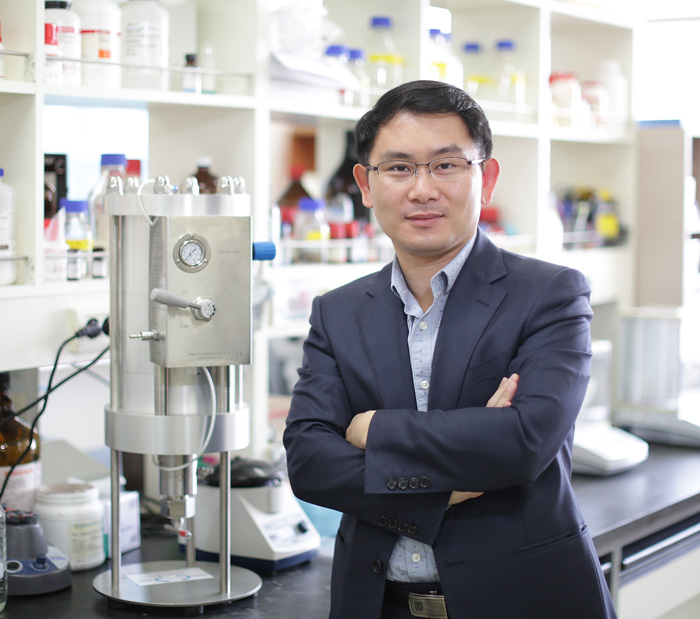Research Stories
Photothermal Therapy for Brain Tumors Using a Rabies Virus-Mimetic Gold Nanorods Platform
Professor Yu Seok YOUN (School of Pharmacy) has developed a brain tumor-targeting treatment and photothermal therapy using gold nanorods that mimic the actual body of the rabies virus.
Pharmacy
Prof.
YOUN, YU SEOK
Professor Yu Seok YOUN (School of Pharmacy) has developed a brain tumor-targeting treatment and photothermal therapy using gold nanorods that mimic the actual body of the rabies virus. A brain tumor (glioblastoma) is one of the most fatal types of cancer because patients with it have a very short average survival rate of 14.6 months. Many researchers have had great difficulty developing an effective therapeutic because of the dense brain capillary endothelial structure, so-called, blood-brain barrier (BBB), which is considered to be a crucial hurdle for the treatment of brain tumors. To solve this problem, the research team suggested a unique platform of rabies virus-mimetic gold nanorods (AuNRs) that have the ability to reach the brain tumors by bypassing the BBB. These AuNRs emitted heat (~50°C) in response to the irradiation of near infrared (NIR) light and thus suppressed tumor growth.
In detail, the research team has designed and fabricated a unique gold nanorod structure that closely mimics many features of the rabies virus, such as its size, shape, and surface morphologies, for the purpose of enhancing the ability to target brain tumors. The rabies virus causes deadly symptoms such as hydrophobia and encephalomyelitis when humans are infected by it. However, the rabies virus has special ability to enter the central nervous system (CNS) and eventually bypass the BBB and reach the brain tumor site because rabies virus glycoprotein (RVG) specifically binds to the nicotinic acetylcholine receptors present in the human body (Figure 1). In particular, the unique shape of the rabies virus, which is like a bullet or rod, is advantageous for neuronal pathway migration and it is characterized by its ability to penetrate into the CNS.
To achieve this strategy, the team fabricated gold nanorods of 80 nm / 20 nm in size (length and width, respectively), to maintain an aspect ratio (AR = length/width: ~4.0) that reacts efficiently to NIR (808 nm). The resulting AuNRs was serially coated by silica and RVG to form a 120 nm / 50 nm nanostructure (AR: 2.34) with very similar size, shape, and surface characteristics to the rabies virus (AR: 2.4) (Figure 1). The prepared gold nanorods displayed remarkable penetration into the brain tumor cells (N2a) when comparing spherical gold nanoparticles with RVG or gold nanorods without RVG, and reached the brains of mice through the CNS as if it was an actual rabies virus. Consequently, the NIR irradiation (808 nm) resulted in increasing tumor temperature (~50°C) and effectively suppressed tumor growth in the N2a cell-inoculated mice (Figure 2).
A brain tumor target therapeutic agent has been proposed by a paradoxical strategy of creating gold nanorods mimicking the biological characteristics of the rabies virus known to be very dangerous to humans. However, there are many steps that need to be overcome for FDA approval of clinically applicable anti-brain tumor nanodrugs. Therefore, interest and research of scientists in related fields are urgently needed, and the importance and value of the development of nanodrugs should be highly evaluated.
The results of this study were published in the world's leading authoritative journal Advanced Materials Online (January 30, 2017) and shown in an article in Science/AAAS Magazine Online (February 10, 2017) entitled "How to Stop Brain Cancer with Rabies”.
※Information about the research paper
- Title: Rabies Virus-Inspired Silica-Coated Gold Nanorods as a Photothermal Therapeutic Platform for Treating Brain Tumors
- Authors: Changkyu LEE (first author, Ph.D. candidate), Ha Shin HWANG, Sungin LEE, Bomi KIM (co-authors, master course), Yu Seok YOUN (corresponding author, professor)

